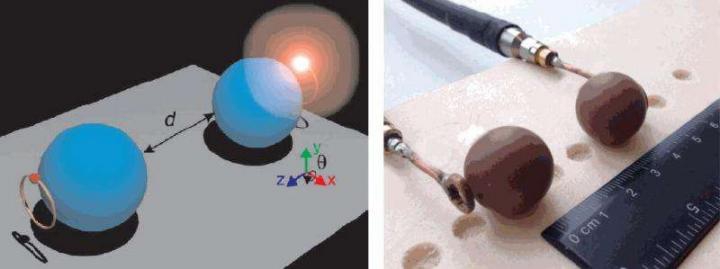
News
ITMO and Giricond achieve wireless power transfer across 20cm
February 4, 2016 | By Anthony Capkun
 An illustration of the wireless power transfer system. Power is transferred from one ceramic sphere to the other using the spheres’ identical magnetic resonance. Photo Song, et al. ©2016 AIP Publishing.
An illustration of the wireless power transfer system. Power is transferred from one ceramic sphere to the other using the spheres’ identical magnetic resonance. Photo Song, et al. ©2016 AIP Publishing. February 3, 2016 – Wireless power transfer systems hold exciting promise for the future and, in a new study, a group of scientists from ITMO University and Giricond Research Institute put forward a wireless power transfer (WPT) system that can maintain up to 80% transfer efficiency across a distance of 20 cm.
The results were tested with a light diode, which the scientists managed to turn on wirelessly.
“This is just a pioneering work, but our experimental setup already works for distances up to 20 cm and 1 watt of power,” said Polina Kapitanova.
Most work on WPT relies on resonance coupling, explain the researchers, where two resonant copper coils can wirelessly exchange power by resonating at the same frequency. (Nearby objects are left unaffected in this process as they are not tuned to the required frequency.) To further reduce unintended interactions, WPT systems couple the coils using magnetic fields that interact very weakly with most other objects, including biological tissues.
This current study exploits the same basic principle but with two modifications that help enhance power transfer efficiency.
The first change was to replace traditional copper coils with spherical dielectric resonators made of ceramic material with high permittivity and low loss. This step made it possible to avoid losses in metals and led to higher efficiency.
To decrease power losses, they used a higher-order resonant frequency mode called magnetic quadrupole mode. The researchers discovered that operating the system at quadrupole mode—rather that dipole mode—not only increases the efficiency of the system, but also makes it less sensitive to the random orientation of the transmitter relative to the receiver.
“Now we are working on fabrication and experimental investigation of the next WPT system prototype,” added Kapitanova. “We believe this prototype will bring us very close to a practical application.”
PHOTO: An illustration of the wireless power transfer system. Power is transferred from one ceramic sphere to the other using the spheres’ identical magnetic resonance. Photo Song, et al. ©2016 AIP Publishing.
Print this page